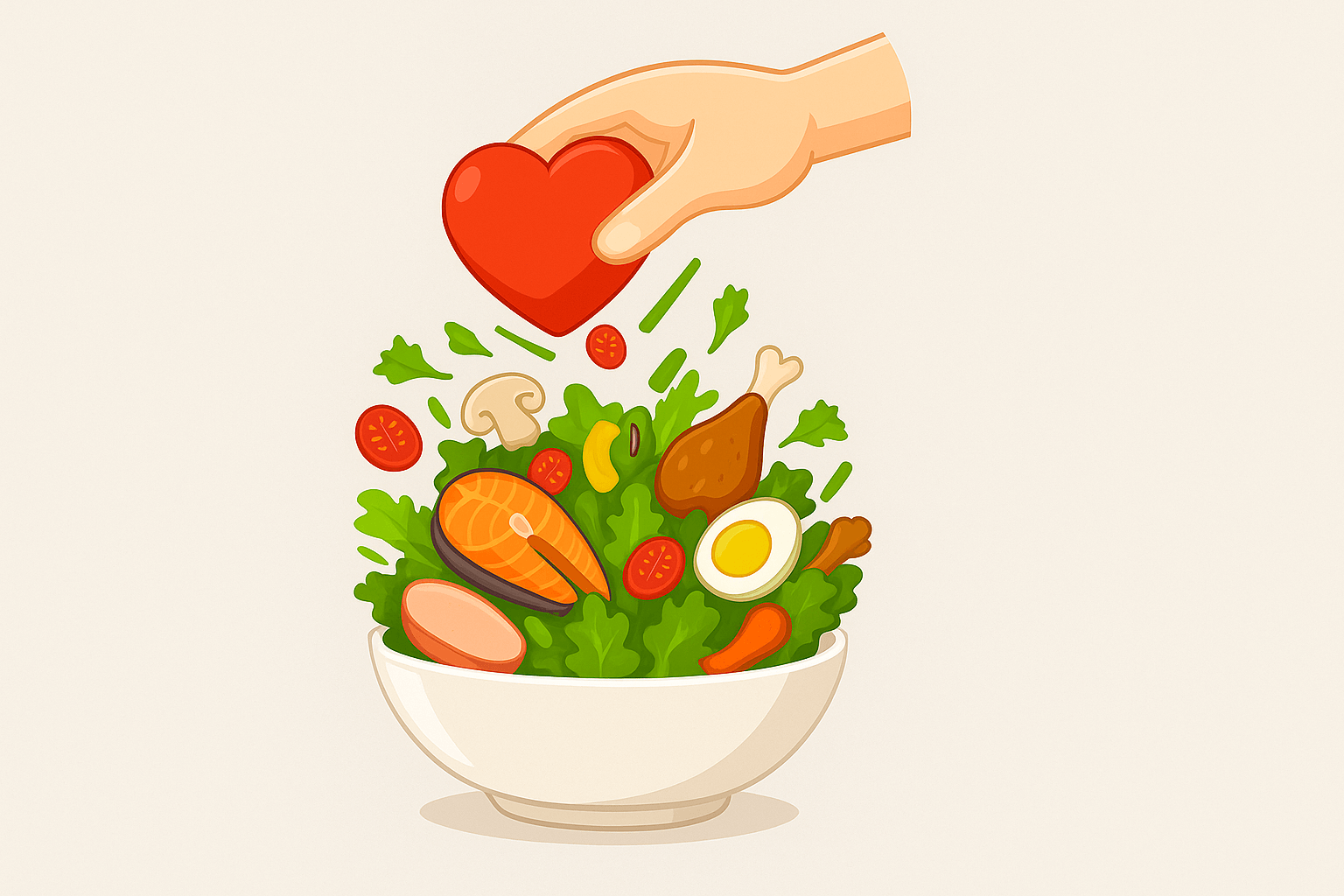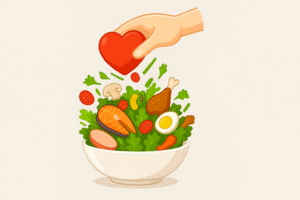In today’s fast-paced world, making sure children eat nutritious and balanced meals can be a real challenge—especially for busy parents. Between school runs, work commitments, and daily routines, preparing wholesome meals that support a child’s growth and wellbeing often feels overwhelming.
According to the British Nutrition Foundation, 1 in 3 parents struggle to maintain a healthy diet for their children due to limited time, lack of inspiration, or not knowing where to start.
Fortunately, this guide makes healthy meal planning simple, practical, and manageable—even with a packed schedule. By following trusted tips and nutritional advice from reputable UK health sources, you’ll learn how to prepare meals that boost your child’s development, save time, and reduce food waste.
Whether you’re looking for school lunchbox ideas or stress-free dinner prep strategies, this article will help you build a healthy, enjoyable, and sustainable diet for children aged 2 to 12.
Why Healthy Eating Matters
Creating healthy eating habits from a young age plays a vital role in a child’s physical health and academic success. According to guidance from the NHS and Public Health England, a balanced diet during childhood can:
🛡️ Strengthen the immune system and lower the risk of infections
🧠 Improve memory, focus, and cognitive development at school
😊 Support stable moods, energy levels, and emotional wellbeing
🦴 Build strong bones, healthy weight, and proper growth
🚫 Help prevent conditions like anaemia, obesity, and Type 2 diabetes
Moreover, a 2022 report by the Royal College of Paediatrics and Child Health revealed that 1 in 4 children in the UK are overweight or obese by age 11. Much of this is linked to poor diets high in sugar and ultra-processed foods.
The earlier children develop healthy food habits, the easier it is to maintain them long-term. Including kids in meal planning and conversations around nutrition also gives them a sense of control—helping them make better food choices for life.
📚 Read more: RCPCH State of Child Health Report
What Should Be on Your Child’s Plate?
A well-balanced plate is the foundation of a healthy diet. It should include the right balance of macronutrients—carbohydrates, proteins, and healthy fats—along with essential vitamins and minerals. The UK’s Eatwell Guide offers a simple, visual way to divide food groups for optimal nutrition.
Here’s a general guide to structuring each meal:
🍇 At least ½ of the plate should be fruits and vegetables
🍞 Around ¼ should be whole grains (e.g. brown rice, oats)
🍗 Another ¼ should be protein sources (e.g. meat, lentils, tofu)
🥑 Include small amounts of healthy fats and oils
🥛 Add a serving of dairy or fortified alternatives for calcium and vitamin D
Not only does this promote physical health, but it also supports better sleep, sharper concentration, and emotional resilience.
🥦 Fruits and Vegetables
Fruits and vegetables are essential for children’s growth. They are rich in fibre, vitamins (especially A and C), potassium, and antioxidants that help fight disease. For better results, encourage variety—aim for a rainbow on the plate. The more colourful the meal, the broader the nutrient range.
Try adding items like berries, oranges, peas, sweetcorn, spinach, or cherry tomatoes to every meal. These can be served raw, steamed, or blended into smoothies.
According to the 5 A Day campaign, children should have at least five portions of fruit and vegetables daily. These portions can be fresh, frozen, tinned, dried, or juiced (in moderation).
🌾 Whole Grains
Whole grains are a key source of long-lasting energy. Unlike refined grains, they contain the bran and germ—making them higher in fibre and B vitamins. This helps support digestion, regulate blood sugar, and reduce unhealthy cravings.
For everyday meals, opt for wholegrain versions of popular staples—such as brown rice, oats, whole-wheat pasta, and wholemeal bread. These choices help keep kids fuller for longer and improve focus during the school day.
🍗 Lean Proteins
Protein is vital for building strong muscles, producing hormones, and keeping the immune system active. Common protein-rich foods include grilled chicken, lentils, beans, eggs, tofu, and Greek yogurt.
Additionally, proteins provide iron and zinc—both essential for children’s development. To maximise absorption of iron, especially from plant-based sources, pair it with a vitamin C-rich food like orange slices or tomatoes.
Include at least one protein source in every meal to prevent fatigue and support red blood cell production.
🥑 Healthy Fats
Healthy fats support brain development, balance hormones, and improve the absorption of vitamins A, D, E, and K. Great sources include avocados, olive oil, flax seeds, oily fish (like salmon), and nut butters.
These fats help children stay energised and support emotional stability. However, it’s important to avoid harmful fats. ❌ Limit saturated fats and avoid trans fats found in processed snacks and deep-fried foods, as they increase inflammation and risk of future heart problems.
Time-Saving Meal Planning Tips
Healthy eating doesn’t have to mean spending hours in the kitchen. With a few simple strategies, busy parents can save time, lower stress, and still prepare meals that support their child’s health.
Effective meal planning also helps reduce food waste, save money, and ensure your child gets a wide variety of essential nutrients each week.
To help you get started, here are proven tips that work—no matter how hectic your schedule is:
🍲 Batch Cook on Weekends
Prepare large portions of kid-friendly meals like stews, vegetable curry, Bolognese sauce, or soup. Freeze them in clearly labelled containers. During the week, simply reheat and serve—saving you cooking time when it matters most.
📅 Use a Weekly Meal Planner
Planning meals in advance keeps the week on track. Map out breakfast, lunch, dinner, and snacks for every day. Stick the plan on the fridge so the whole family knows what’s coming.
➡️ Download free templates from NHS Change4Life.
🥕 Pre-Chop Fruits and Veggies
Right after shopping, wash and chop items like carrots, cucumbers, peppers, and apples. Store them in airtight containers. Pre-cut produce makes it easier to serve healthy snacks instead of reaching for processed ones.
🔁 Rotate Family Favourites
Kids love familiarity. Stick with 5 to 7 reliable, easy-to-make meals—like chicken wraps, spaghetti with lentil sauce, or veggie stir-fries. Rotate them weekly to simplify planning while keeping mealtimes enjoyable.
👧 Let Children Help
When kids are involved in meal planning, they’re more likely to eat what’s served. Ask them to help choose meals, select between healthy snack options, or stir ingredients. This also builds lifelong healthy habits.
🍛 Use a Slow Cooker or Instant Pot
These time-saving tools allow you to prepare big meals with minimal effort. Simply add your ingredients before leaving the house, and return to a hot, ready-to-serve dinner.
🧊 Double Up Recipes
When cooking, make twice the amount and freeze the extra. Having backup meals in the freezer can rescue busy evenings and prevent last-minute takeaways.
🧼 Bonus Tips: Hygiene & Infection Prevention
Food safety is just as important as nutrition—especially when feeding children. Following these NHS-recommended hygiene practices helps reduce the risk of foodborne illness:
✋ Wash hands before preparing food and after handling raw meat or eggs.
🔪 Keep raw foods and cooked foods separate to avoid contamination.
❄️ Store perishable foods in the fridge below 5°C, and reheat leftovers until piping hot (above 70°C).
🏷️ Label and date frozen meals, and use them within 1 to 3 months.
Sample Day of Healthy Meals for Kids
Planning a balanced day of meals can help meet your child’s nutritional needs while supporting growth, learning, and energy. Below is a sample meal plan designed for children aged 4 to 12. You can adjust portion sizes depending on your child’s age, appetite, and activity level.
🕖 Breakfast
Whole grain toast with scrambled eggs + orange slices
☑️ Provides slow-release energy, high-quality protein, vitamin D, and vitamin C
🕙 Mid-Morning Snack
Low-fat Greek yogurt topped with blueberries
☑️ Rich in calcium, probiotics, and antioxidants that support gut and brain health
🕛 Lunch
Wholemeal chicken wrap with spinach, hummus, and grated carrots
☑️ Delivers lean protein, fibre, and essential minerals like iron and folate
🕒 Afternoon Snack
Apple slices with natural peanut butter or almond butter
☑️ Offers fibre, healthy fats, and vitamin E for sustained focus and energy
🕕 Dinner
Grilled salmon with brown rice, steamed broccoli, and roasted sweet potato
☑️ Packed with omega-3s, magnesium, potassium, and B vitamins to support brain development and bone health
💧 Hydration
Encourage your child to drink 6–8 cups of water daily.
For variety, serve milk or diluted 100% fruit juice (1 part juice to 10 parts water), but limit sugary drinks.
(Reference: NHS – Children’s Nutrition)
Smart Snacking Ideas
Snacks play a big role in maintaining your child’s energy and focus throughout the day. Rather than processed or sugary options, go for nutrient-dense snacks that support growth and reduce cravings.
Here are quick and healthy snack ideas you can prepare in minutes:
🥒 Sliced cucumbers and carrots with hummus
– High in fibre, vitamin K, and plant-based protein
🧀 Cheddar cubes with whole grain crackers
– A tasty combo of calcium and slow-digesting carbohydrates for energy
🍓 Homemade smoothie (banana + milk + flaxseed + spinach)
– A powerful mix of fibre, omega-3s, iron, and vitamin C
🥚 Boiled egg with cherry tomatoes
– Excellent source of protein, vitamin A, and antioxidants like lycopene
🥜 Trail mix (unsalted nuts + raisins + seeds)
– Ideal for children aged 5+; provides good fats, zinc, and sustained energy
🍌 Banana pancakes (just banana + egg)
– Naturally sweet, high in protein, and fun to make
💡 Pro Tip: Keep grab-and-go snacks in a designated “Snack Zone” in your fridge. This encourages independence while guiding children to make smart food choices.
(Source: British Nutrition Foundation – Healthy Snacks for Kids)
Common Picky Eating Solutions
Fussy eating is a common concern for many parents—but it doesn’t have to turn every meal into a struggle. With patience and a bit of creativity, you can transform mealtimes into a fun and positive experience.
Encouraging your child to try new foods early builds confidence and sets the foundation for a lifetime of healthy eating.
Here are proven strategies to support your picky eater:
🍽️ Turn Meals into an Adventure
Make food visually fun using colourful plates, food cutters, or bento-style lunchboxes. A playful presentation can spark curiosity and encourage kids to try something new.
👅 Try the “One-Bite Challenge”
Invite your child to take just one bite of a new food—no pressure. Often, that single bite is enough to break resistance and create a new favourite.
❌ Skip Pressure or Bribes
Avoid using food as a reward or punishment. Mealtimes should feel calm and supportive, not stressful or forced.
🔁 Pair New with Familiar
Introduce unfamiliar foods alongside something they already enjoy. This builds trust and makes the new food feel less intimidating.
🔄 Stay Consistent and Patient
Children may need 10–15 exposures to accept a new food. Keep offering it in small amounts without forcing it—consistency makes all the difference.
👨👩👧 Be a Role Model
Children often copy what they see. When they see you enjoying fruits and vegetables, they’re more likely to give them a try too.
📚 Source: NHS – Fussy Eaters
Healthy Packed Lunch Ideas
A nutritious lunchbox fuels your child’s afternoon energy, mood, and focus. The key is to keep it simple, colourful, and balanced. Follow the UK’s School Food Standards, and aim for a mix of:
✔️ Complex carbohydrates
✔️ Lean proteins
✔️ Healthy fats
✔️ Fibre-rich fruits and vegetables
🧺 Balanced Lunchbox Combos
🥪 Wholegrain chicken sandwich + lettuce + cucumber sticks + apple wedges + water
🥗 Mini pasta salad + cherry tomatoes + sweetcorn + grated cheese + fruit pot
🧆 Falafel and spinach wrap + Greek yogurt pot + ripe banana
🍙 Leftover salmon rice bowl + peas + orange segments + refillable water bottle
💡 Tip: Use an insulated lunchbox and include an ice pack to keep food fresh. Rotate combos weekly to maintain interest and variety.
Food Allergy Safety & Awareness
When preparing food for children with allergies, safety must come first. Whether at home, school, or childcare settings, awareness and prevention are key.
Follow these practical tips to create allergy-friendly meals:
🏷️ Always read labels, even for familiar products—ingredients can change unexpectedly.
🍴 Avoid cross-contamination by using separate utensils and cleaning surfaces thoroughly.
🏫 Communicate clearly with schools, clubs, and caregivers to ensure everyone knows your child’s allergy plan.
🌱 Use allergy-friendly swaps like oat milk instead of cow’s milk or sunflower butter instead of peanut butter.
🔎 Explore resources from Allergy UK for factsheets, safe recipes, and emergency plans.
Nutrition & Portion Checklist by Age
Children’s nutritional needs change as they grow. While balance is always important, portion sizes should match their age and activity level to avoid under- or over-feeding.
🍎 Ages 4–7
5 portions of fruit and vegetables daily
3–4 servings of wholegrains (e.g. oats, brown rice, wholemeal bread)
2–3 dairy portions or fortified alternatives
1–2 servings of lean protein (e.g. beans, eggs, poultry)
6–8 cups of water per day
🍏 Ages 8–12
5+ portions of fruit and veg daily
4–5 servings of wholegrains for steady energy
3 portions of dairy or fortified alternatives
2–3 protein servings (e.g. fish, tofu, eggs, meat)
6–8 cups of water, plus extra after sports
📌 Tip: Young children have smaller stomachs than adults, so offering smaller, more frequent meals helps meet their energy needs.
📚 Source: BNF – Nutrition Requirements by Age
Final Thoughts: Building Healthy Habits That Last
Healthy meal planning for children doesn’t need to be complicated, time-consuming, or stressful. With the right strategies—like batch cooking, smart snacking, and involving your child in food choices—you can make nutritious eating part of everyday family life.
By offering balanced meals filled with fruits, vegetables, whole grains, lean proteins, and healthy fats, you’re not just feeding your child—you’re shaping lifelong habits that support their growth, learning, and emotional wellbeing.
Remember: small changes make a big difference over time. Whether it’s packing a colourful lunchbox or trying a new veggie together at dinner, every effort counts.



